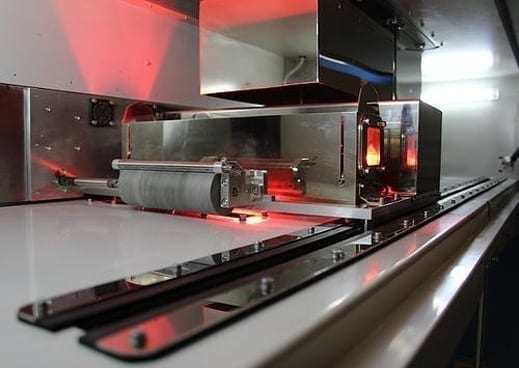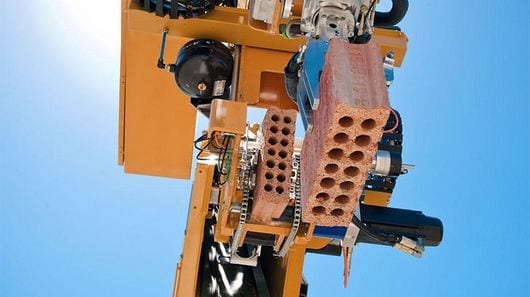
A larger version of this high-speed sintering machine is now in the works.
An emerging additive manufacturing technology could be fast and cheap enough to compete with conventional methods, but it faces materials-related challenges
The inventor of a new kind of 3-D printer says his research group will build a massive machine capable of mass-producing competitively priced plastic parts within two years.
Making plastic parts layer by layer according to digital instructions is a very slow process compared with conventional methods. That’s why additive manufacturing–or 3-D printing, as it is more popularly known–has thus far been economical only for making small batches of niche products like dental implants and hearing-aid shells. The new technique could increase the number of parts that can be made economically this way from thousands to millions at a time, at least for small, complicated objects.
Compared with conventional technologies like injection molding, additive manufacturing could significantly reduce material use and eliminate the costly machine tooling needed to make certain complicated shapes. It also makes it more practical to design unique architectures for parts that, for example, could help make automobiles and aircraft lighter and more fuel-efficient (See “10 Breakthrough Technologies 2013: Additive Manufacturing”).
Neil Hopkinson, a professor of mechanical engineering at the University of Sheffield in the United Kingdom, has been developing the new method, called high-speed sintering, for over a decade.
Laser sintering machines build objects by using a single-point laser to melt and fuse thin layers of powdered polymer, one by one. Hopkinson replaced the laser system, which is both expensive and slow, with an infrared lamp and an ink-jet print head. The print head rapidly and precisely delivers patterns of radiation-absorbing material to the powder bed. Subsequently exposing the powder to infrared light melts and fuses the powder into patterns, and the machine creates thin layers, one by one—similar to the way laser sintering works, but much faster.
Hopkinson’s group has already shown that the method works at a relatively small scale. They’ve also calculated that, given a large enough building area, high-speed sintering is “on the order of 100 times faster” than laser sintering certain kinds of parts, and that it can be cost competitive with injection molding for making millions of small, complex parts at a time, says Hopkinson. Now the group will actually build the machine, using funding from the British government and a few industrial partners.
High-speed sintering has the potential to be “very quick,” and the process could end up being much cheaper than laser sintering in certain cases, says Phil Reeves, the vice president of strategic consulting for Stratasys, a leading maker of many kinds of additive manufacturing machines and materials. However, a lot of work is still needed to develop materials that can work with the process, he says. Judging from what Hopkinson has made public, the range of plastics that work with high-speed sintering is quite limited, Reeves says, and many widely used plastics may not be compatible with the process, since it relies on combining the powder with an additional, light-absorbing material.
Read more: Could This Machine Push 3-D Printing into the Manufacturing Big Leagues?
The Latest on: 3D Manufacturing
[google_news title=”” keyword=”Mengla virus” num_posts=”10″ blurb_length=”0″ show_thumb=”left”]
via Google News
The Latest on: 3D Manufacturing
- The Covid-19 Pandemicon May 15, 2024 at 10:05 am
With the acute phase of the Covid-19 pandemic fading even as the coronavirus persists and evolves, a new normal is taking shape around the world. The decision came after a scorching hearing in ...
- Best Antivirus Software for 2024on May 14, 2024 at 2:00 pm
Clifford is a managing editor at CNET, where he leads How-To coverage. He spent a handful of years at Peachpit Press, editing books on everything from the first iPhone to Python. He also worked at ...
- What to know about the bird flu outbreak in the US after virus fragments found in milk sampleson April 25, 2024 at 8:38 am
Several dairy cows have been infected, resulting in milk samples showing inactive remnants of the virus, and one human case has been confirmed. Health officials say the food supply is safe and the ...
- World's chocolate supply threatened by devastating viruson April 22, 2024 at 4:59 pm
A rapidly spreading virus threatens the health of the cacao tree and the dried seeds from which chocolate is made, jeopardizing the global supply of the world's most popular treat. Farmers can ...
- Measles outbreak in Chicago: What to know about the viruson March 27, 2024 at 9:50 am
Though most vaccinated people have close to zero chance of contracting the virus, here’s what to know about the disease. Yes, they do. In fact, measles, which was considered eliminated in the ...
- New study shows virus-like particle can effectively 'shock and kill' latent HIV reservoiron March 26, 2024 at 7:29 am
In the study published in the journal Emerging Microbes and Infections, the team demonstrated that the patented therapeutic candidate, an HIV-virus-like-particle (HLP), is 100 times more effective ...
- Inside the Coronaviruson February 3, 2024 at 9:56 am
We show how the immune system would normally attempt to neutralize virus particles and how CoV-2 can block that effort. We explain some of the virus's surprising abilities, such as its capacity to ...
- Vaccination from the Misinformation Viruson August 3, 2021 at 5:22 pm
Adjust the colors to reduce glare and give your eyes a break. Use one of the services below to sign in to PBS: You've just tried to add this video to My List. But first, we need you to sign in to ...
- Genetics of the Influenza Viruson September 9, 2019 at 1:44 pm
Reid, A. H., & Tautenberger, J. K. The origin of the 1918 pandemic influenza virus: A continuing enigma. Journal of General Virology 84, 2285–2292 (2003) ...
- Mac Virus Scan: How to protect your Mac from malwareon May 27, 2015 at 11:56 am
Initiating a virus scan is an easy process that usually begins with the user clicking a Scan or Smart Scan button. Expect the scan to take a while if there is a lot of data on your Mac.
via Bing News











